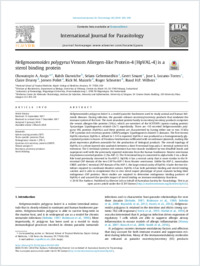Heligmosomoides polygyrus venom allergen-like protein-4 (HpVAL-4) is a sterol binding protein
- Asojo, Oluwatoyin A. National School of Tropical Medicine, Baylor College of Medicine, Houston, USA
- Darwiche, Rabih Division of Biochemistry, Department of Biology, University of Fribourg, Switzerland
- Gebremedhin, Selam National School of Tropical Medicine, Baylor College of Medicine, Houston, USA
- Smant, Geert Laboratory of Nematology, Wageningen University, The Netherlands
- Lozano-Torres, José L. Laboratory of Nematology, Wageningen University, The Netherlands
- Drurey, Claire Wellcome Centre for Molecular Parasitology, University of Glasgow, UK
- Pollet, Jeroen National School of Tropical Medicine, Baylor College of Medicine, Houston, USA
- Maizels, Rick M. Wellcome Centre for Molecular Parasitology, University of Glasgow, UK
- Schneiter, Roger Division of Biochemistry, Department of Biology, University of Fribourg, Switzerland
- Wilbers, Ruud H. P. Laboratory of Nematology, Wageningen University, The Netherlands
-
02.03.2018
Published in:
- International Journal for Parasitology. - 2018, vol. 48, no. 5, p. 359–369
English
Heligmosomoides polygyrus bakeri is a model parasitic hookworm used to study animal and human helminth diseases. During infection, the parasite releases excretory/secretory products that modulate the immune system of the host. The most abundant protein family in excretory/secretory products comprises the venom allergen-like proteins (VALs), which are members of the SCP/TAPS (sperm-coating protein/Tpx/antigen 5/pathogenesis related-1/Sc7) superfamily. There are >30 secreted Heligmosomoides polygyrus VAL proteins (HpVALs) and these proteins are characterised by having either one or two 15 kDa CAP (cysteine-rich secretory protein (CRISP)/antigen 5/pathogenesis related-1) domains. The first known HpVAL structure, HpVAL-4, refined to 1.9 Å is reported. HpVAL-4 was produced as a homogeneously glycosylated protein in leaves of Nicotiana benthamiana infiltrated with recombinant plasmids, making this plant expression platform amenable for the production of biological products. The overall topology of HpVAL-4 is a three layered αβα sandwich between a short N-terminal loop and a C-terminal cysteine rich extension. The C- terminal cysteine rich extension has two strands stabilized by two disulfide bonds and superposes well with the previously reported extension from the human hookworm Necator americanus Ancylostoma secreted protein-2 (Na-ASP-2). The N-terminal loop is connected to alpha helix 2 via a disulfide bond previously observed in Na-ASP-2. HpVAL-4 has a central cavity that is more similar to the N-terminal CAP domain of the two CAP Na-ASP-1 from Necator americanus. Unlike Na-ASP-2, mammalian CRISP, and the C-terminal CAP domain of Na-ASP-1, the large central cavity of HpVAL-4 lacks the two histidines required to coordinate divalent cations. HpVAL-4 has both palmitate-binding and sterol-binding cavities and is able to complement the in vivo sterol export phenotype of yeast mutants lacking their endogenous CAP proteins. More studies are required to determine endogenous binding partners of HpVAL-4 and unravel the possible impact of sterol binding on immune-modulatory functions.
- Faculty
- Faculté des sciences et de médecine
- Department
- Département de Biologie
- Language
-
- English
- Classification
- Biological sciences
- License
-
License undefined
- Identifiers
-
- RERO DOC 309428
- DOI 10.1016/j.ijpara.2018.01.002
- Persistent URL
- https://folia.unifr.ch/unifr/documents/306933
Other files
Statistics
Document views: 109
File downloads:
- pdf: 186
- Supplementary material: 119

